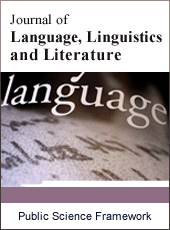Journal of Language, Linguistics and Literature
Articles Information
Journal of Language, Linguistics and Literature, Vol.1, No.4, Aug. 2015, Pub. Date: Jul. 21, 2015
On the Iranian EFL Learners' Sources of Errors in the Production of Propositions
Pages: 120-126 Views: 5985 Downloads: 2308
[01]
Ali Forutan, English Department, Farhangian University of Isfahan, Isfahan, Iran.
[02]
Fatemeh Mehranpour, Faculty of Persian Literature and Foreign Languages, English Department, Islamic Azad University, South Tehran Branch, Tehran, Iran.
The purpose of the present study is to detect to what extent Iranian EFL learners commit errors attributable to the cross-linguistic differences between their L1(Target language) and L2( Source language). Furthermore locating the types of errors in use of prepositions (omission of prepositions, redundant or wrong use of prepositions) is among the objective of the study. In the direction of checking the status of various categories of errors of prepositions made by Iranian EFL learners as a result of the transitional limitations between Persian and English, an error analysis was performed. Therefore, the researcher developed a translation task in order to find out the interlingual preposition errors committed the participants as a result of transfer between L1 and L2. A total number of 60 male and female students studying English at the intermediate level took part in the study and carried out the translation task. The analysis of the results indicated significant differences between different types of errors made by the participants. The fact of the matter is that Iranian EFL learners had the most problems in terms of the the errors related to the redundent use of prepositions. They stood in the second position concerning the errors in the area of wrong use of prepositions and finally they had the less frequent errors with respect to the omission of prepositions in L2 while translating from Persian into English.
Contrastive Analysis, Negative Transfer, Intralingual, Error Analysis, EFL, ESL
[01]
Abbasi, M., & Karimnia, A. (2011). An analysis of grammatical errors among Iranian translation students: Insights from interlanguage theory. European Journal of Social Sciences, 25 (4), 525-536.
[02]
Asma, T. (2010). Transfer of simple prepositions from standard Arabic into English: The case of third year LMD students of English language at Mentouri University-Constantine. Unpublished M.A. Thesis. Mentouri University-Constantine, Algeria.
[03]
Brown, H. D. (1987). Principles of language learning and teaching. Englewood Cliffs, NJ: Prentice Hall, Inc.
[04]
Brown, H. D. (1994). Teaching by principles: an interactive approach to language pedagogy. Englewood Cliffs, NJ: Prentice Hall Regents.
[05]
Brown, H. D. (2000). Principals of language learning and teaching (4th ed.). New York: Longman.
[06]
Corder, S. P. (1967). The significance of learners’ errors. International Review of Applied Linguistics in Language Teaching (IRAL), 5 (4), 161−170. http://dx.doi.org/10.1515/iral.1967.5.1-4.161
[07]
Corder, S. P. (1987). Error analysis and interlanguage. Oxford: Oxford University Press.
[08]
Dessouky, S. (1990). Error analysis: A non-stop area of research. Studies in Curricula and Methodology, 8, 146-176.
[09]
Ellis, R. (1996). Second language acquisition research and language teaching. Oxford University Press
[10]
Ferris, D. R., & Hedgcock, J. S. (2005). Teaching ESL composition: Purpose, process, and practice (2nd ed.). New Jersey: Lawrence Erlbaum Associates, Publishers.
[11]
Keshavarz, M. H. (1999). Contrastive analysis and error analysis. Tehran: Rahnama Publications.
[12]
Khodabandeh, F. (2007). Analysis of students' errors: The case of headlines.The Asian ASP Journal, 3 (1), 6-21.
[13]
Koosha, M. & Jafarpour, A. A. (2006). Data-driven Learning and Teaching Collocation of Prepositions: The Case of Iranian EFL Adult Learners. Asian EFL Journal, 8(4), 192-209.
[14]
Leedy, P.D. (1993). Practical research: planning and design. 5th ed. New York: McMillan.
[15]
Lin, S. (2002). A case study of English writing competence of students at the Mei Ho Institute of Technology. Journal of Mei Ho Institute of Technology, 20, 180-206
[16]
Mahmoud, A. (2011). The role of interlingual and intralingual transfer in learner-centered EFL vocabulary instruction. Arab World English Journal, 2(3), 28-47.
[17]
Matsuda, P. K., Canagarajah, A. S., Harklau, L., Hyland, K., Warschauer, M. (2003). Changing currents insecond language writing research: A colloquium. Journal of Second Language Writing. 12, 151-179. http://dx.doi.org/10.1016/S1060-3743(03)00016-X
[18]
Namvar, F., Nor, M. F. N., Ibrahim, N., & Mustafa, J. (2012). Analysis of collocations in the Iranian postgraduate students’ writings. The Southeast Asian Journal of English Language Studies, 18 (1), 11-22.
[19]
Nayernia, M. (2011). Writing errors, what they can tell a teacher? MJAL, 3 (2), 200-218. Richards, J. C. (1974). Error analysis: Perspectives on second language acquisition.London: Longman Group Ltd.
[20]
Pittman, G. A. (1966). Activating the use of prepositions. London: Longman.
[21]
Quirk, R. et al. (1993). A University Grammar of English. London: Longman.
[22]
Sattari, A. (2012). An analysis of grammatical errors in Iranian students' English writings.Iranian EFL Journal, 8 (2), 143-157.
[23]
Selinker, L. (1972). Interlanguage. International Review of Applied Linguistics in Language Teaching (IRAL), 10 (3), 209−231. http://dx.doi.org/10.1515/iral.1972.10.1-4.209
[24]
Takahaski, G. (1969). Perceptions of space and function of certain English prepositions. Language Learning, 19, 217-234.
[25]
Yang, W. (2010). A tentative analysis of errors in language learning and use. Journal of Language Teaching and Research, 1 (3), 266-268.

ISSN Print: 2381-7054
ISSN Online: 2381-7062
Current Issue:
Vol. 6, Issue 1, March Submit a Manuscript Join Editorial Board Join Reviewer Team
ISSN Online: 2381-7062
Current Issue:
Vol. 6, Issue 1, March Submit a Manuscript Join Editorial Board Join Reviewer Team
| About This Journal |
| All Issues |
| Open Access |
| Indexing |
| Payment Information |
| Author Guidelines |
| Review Process |
| Publication Ethics |
| Editorial Board |
| Peer Reviewers |


